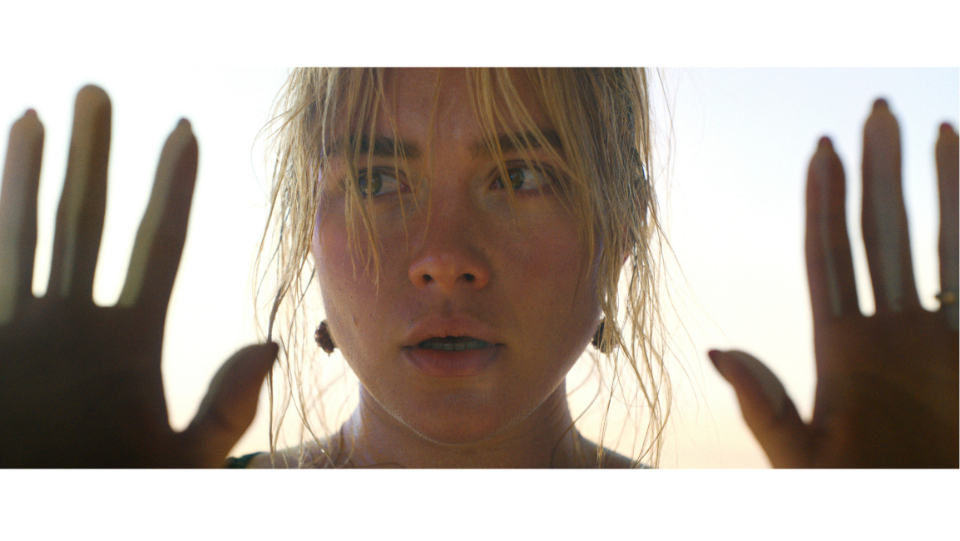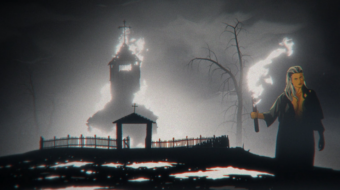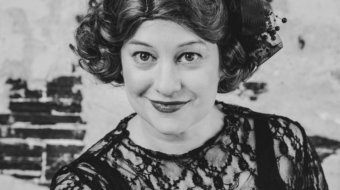
There’s a certain idealization when it comes to the way people look at the 1950s. Countless films highlight the glitz and glamor of old Hollywood, with women in perfectly-fitted hourglass figure dresses and promises of prosperity coloring the era. Of course, it only takes a sober look at history to know there was a good amount of strife during that time. This included—but was not limited to—racial segregation, gender inequality, and wealth disparities. There were deep cracks in the perfectly polished image. It seems fitting then that the new psychological thriller Don’t Worry Darling leans into the aesthetic of that era to tell a story where characters aim for the American Dream, which has plenty of nightmares brimming underneath the surface.
Beautiful cinematography, focused directing, and a few compelling performances make Don’t Worry Darling an entertaining joy ride with substance. Unfortunately, the ambitious film is guilty of biting off more than it can chew, resulting in some glaring plot holes and an overstuffed third act.
Directed by Olivia Wilde, with a screenplay by Katie Silberman, Don’t Worry Darling tells the story of a young couple, Alice (Florence Pugh) and Jack (Harry Styles), who live in a beautiful company town seemingly out of the 1950s. All the men work at the secretive Victory Project, while all of the women are stay-at-home wives and mothers. The town is led by Victory Project founder Frank (Chris Pine), who preaches a philosophy of order that is followed with a cult-like fervor by everyone. The young couple’s life seems ideal and perfect, until things start to happen that make Alice question her reality and the image of their small town. It’s a thriller that will have viewers trying to figure out the truth from the very beginning, with some interesting social commentary along the way.
First off, this film is gorgeous to look at. For all of the problems in the 1950s, fashion was not one of them. Don’t Worry Darling fully embraces this glamorous aesthetic, allowing for all the scenes to be painted with vibrant energy. There’s something dark going on in this town, but the contrast of bright colors and sunshine helps to subvert the idea of perfection and happiness. Viewers are made to almost envy the desert oasis that is presented to them, while feeling unease that something just isn’t quite right.
Director Wilde does a fine job playing up this aesthetic while centering on Alice’s mental unraveling. She uses the camera to lull us into a sense of normalcy before we are, at times, abruptly presented with jarring imagery. There’s a heavy focus on Alice’s journey, and Wilde makes a point to give us constant close-ups and shots of the faces of the characters, however subtle they are in their reactions. There’s an arthouse style to the film that almost feels dreamlike. It goes well with the story, although at times some scenes feel overindulgent, as if they’re there because Wilde thought they would look cool, rather than serving any real purpose.
There are some poignant themes presented throughout the film as well. Questions regarding conformity, gender roles, and the myth of the nuclear family come into play. Interestingly enough, this almost serves a dual purpose. Going back to the idealization of the 1950s, there was this idea that men made the money, women took care of the home, and this was “true” balance. Let certain far-right conservatives tell it, and you would be made to believe that this was the perfect time for everyone, and things only got “worse” when women started wearing pants, choosing when or if to have children, and the nuclear family (a heterosexual couple and their dependent children) began its “breakdown.” Yet, there is an important need to push back against this sugar-coating of history.
That’s because everything was not perfect, and everyone wasn’t happy. Women were kept financially dependent on their husbands. In most places, they weren’t allowed to open their own bank accounts in the United States until the 1960s, and it wouldn’t be until 1974 that they were even allowed to have their own credit cards without a husband co-signing for it. Women weren’t allowed to divorce without proving “wrongdoing” on the husband’s part until 1985. Not to mention the myth that all women were stay-at-home wives, since plenty of women were working class—and fighting for equal wages to their male counterparts—long before the 1950s.
Despite these hard facts throwing cold water on the fantasy of ’50s, you still have a certain segment of our modern population that professes to long for those “simpler” times. These same people push for legislation that reverses progress under the guise of getting things back to the way they “used to be.” This is important to remember when watching Don’t Worry Darling.
Now, with all that great stuff to take in, there are some aspects of the film that are not so great. I could argue that Don’t Worry Darling is a film one needs to watch more than once to really understand everything that happens. That’s because by the third act, the steady pace is suddenly overrun with a lot of new rules told to the audience, rules clearly intended to make the last parts of the movie make some sense.
That’s unfortunate, because the film was doing so well in the beginning in not being convoluted. Things were weird, but they were done in a way that allowed viewers to suspend disbelief and look the other way on irregularities. By the final half-hour of the film, however, that is no longer the case. Certain revelations are made which feel rushed and nonsensical. It’s not to such an extent that requires you to watch it more than once to understand, but rather the revelations don’t do the best job of explaining themselves. Loose ends are not tied.
If you sit through the two hours and thirty-eight minutes’ runtime expecting for it all to make complete sense in the end, you will be disappointed.
Pugh gives a solid performance as Alice. If you’ve seen her in other films, such as Midsommar, then you’ll be getting much of the same here. She doesn’t necessarily break new ground, but her portrayal of Alice is inviting enough that viewers will care what happens to the character.
The standout portrayal goes to Pine, as the town leader, Frank. It almost seems like the movie doesn’t truly start until he comes on screen. Frank is a layered and perhaps dangerous character, exemplifying the so-called ideal image of masculinity. The scenes where he and Pugh are together give some of the best moments of the movie. It almost seems like a missed opportunity that Don’t Worry Darling doesn’t focus on that dynamic the most. This brings me to the second glaring issue of the film: the relationship between Alice and Jack.
They did a disservice with the marketing of this movie. The posters would have you believe it’s about a couple, when in reality it’s about Alice. Jack’s role is played up more than it should have been, which leads to expectations. Expectations, that unfortunately, Styles—who plays Jack—doesn’t meet. It’s not so much that he gives a lackluster performance, but it becomes clear that there’s a disconnect between the character he’s supposed to be versus the character Styles decided to portray. It’s a miscast, and so instead of it adding to Alice’s story, it becomes more background dressing and a way to fit in a few sex scenes.
Don’t Worry Darling isn’t perfect, but it doesn’t have to be. Overall, it’s a thriller with something to say and commentary worth listening to. Don’t worry viewers (see what I did there), you’ll be entertained with themes that make you think.
Don’t Worry Darling is available in theaters September 23, 2022.










